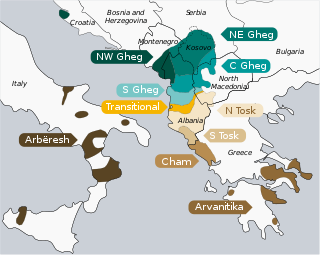Loading AI tools
Group of varieties of the Albanian language From Wikipedia, the free encyclopedia
Tosk (Albanian definite form: toskërishtja) is the southern group of dialects of the Albanian language, spoken by the ethnographic group known as Tosks. The line of demarcation between Tosk and Gheg (the northern variety) is the Shkumbin River. Tosk is the basis of the standard Albanian language.
| Tosk | |
|---|---|
| toskërishtja | |
| Region | Albania, Kosovo, North Macedonia, Italy, Greece, Turkey |
Native speakers | 1.8 million (2011 census)[1] |
Early form | |
| Dialects |
|
| Albanian alphabet, formerly Elbasan | |
| Language codes | |
| ISO 639-3 | als |
| Glottolog | alba1268tosk1239 |
| Linguasphere | to 55-AAA-ace 55-AAA-aca to 55-AAA-ace |
 A map showing Tosk speakers in the two palest shades of brown. | |
Major Tosk-speaking groups include the Myzeqars of Myzeqe, Labs of Labëria, Chams of Çamëria, Arvanites of Greece and the Arbëreshë of Italy, as well as the original inhabitants of Mandritsa in Bulgaria. In North Macedonia, there were approximately 3000 speakers in the early 1980s.[2]
This section should specify the language of its non-English content, using {{lang}}, {{transliteration}} for transliterated languages, and {{IPA}} for phonetic transcriptions, with an appropriate ISO 639 code. Wikipedia's multilingual support templates may also be used. (August 2020) |
Seamless Wikipedia browsing. On steroids.
Every time you click a link to Wikipedia, Wiktionary or Wikiquote in your browser's search results, it will show the modern Wikiwand interface.
Wikiwand extension is a five stars, simple, with minimum permission required to keep your browsing private, safe and transparent.